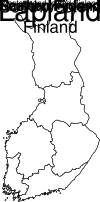Regional differences in long-term cycles and seasonality of Puumala virus infections, Finland, 1995-2014
- PMID: 27113030
- PMCID: PMC9150413
- DOI: 10.1017/S0950268816000765
Regional differences in long-term cycles and seasonality of Puumala virus infections, Finland, 1995-2014
Abstract
Puumala hantavirus (PUUV) causes haemorrhagic fever with renal syndrome in humans, an endemic disease in Finland. We aimed to study recent trends in PUUV infections in Finland, to evaluate whether there are regional differences in seasonality and long-term cycles and whether the patterns have changed over time. We analysed serologically confirmed acute PUUV infections reported to the National Infectious Disease Register from 1 April 1995 to 31 March 2014. A total of 30 942 cases of PUUV infections were identified during the study period. The average annual incidence was 31 cases/100 000 person-years with the highest in Eastern Finland and the lowest in Southwestern Finland. Throughout Finland there was not an increasing trend in incidence but changes in incidence, seasonality and long-term cycles differed regionally. Long-term cycles supported by high Bayesian posterior probabilities (73-100%) differed between the south and the north, shifting from 3 to 4 years, respectively. Temporal changes in seasonality were most prominent in Southwestern Finland. The pattern of human PUUV infection epidemiology probably primarily reflects the spatio-temporal interaction between bank-vole population dynamics and climate.
Keywords: Epidemiology; hantavirus; statistics; surveillance; zoonoses.
Figures




References
-
- Vaheri A, et al. Hantavirus infections in Europe and their impact on public health. Reviews in Medical Virology 2013; 23: 35–49. - PubMed
-
- Olsson GE, Leirs H, Henttonen H. Hantaviruses and their hosts in Europe: reservoirs here and there, but not everywhere? Vector Borne and Zoonotic Diseases (Larchmont, NY) 2010; 10: 549–561. - PubMed
-
- Faber MS, et al. Steep rise in notified hantavirus infections in Germany, April 2010. Eurosurveillance 2010; 15: 19574. - PubMed
MeSH terms
LinkOut - more resources
Full Text Sources
Other Literature Sources
Miscellaneous

